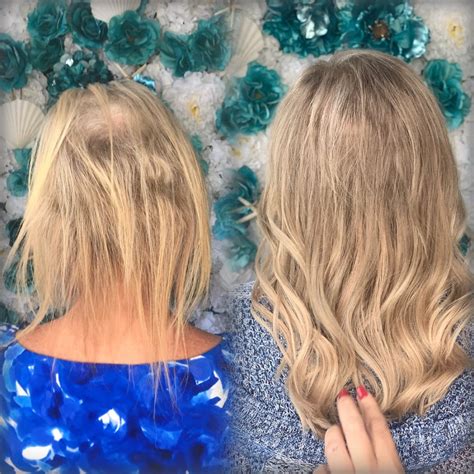Are you struggling with thinning hair, leaving you feeling self-conscious and affecting your overall well-being? You’re not alone. According to the American Academy of Dermatology (AAD), approximately 50% of women and 25% of men experience hair thinning as they age. The reasons for thinning hair are as varied as genetics, hormonal changes, styling habits, and underlying medical conditions.

The Distress of Thinning Hair
For many, thinning hair can be a significant source of emotional distress, affecting self-esteem, confidence, and social interactions. Studies have shown that individuals with thinning hair often experience feelings of embarrassment, frustration, and anxiety. They may avoid social situations, withdraw from relationships, and feel less attractive.
The Power of Extensions for Thinning Hair
Hair extensions offer a transformative solution for thinning hair, providing instant volume, length, and thickness without affecting the health of your natural hair. They seamlessly blend with your existing hair, creating a fuller, more natural appearance.
Types of Extensions for Thinning Hair
There are various types of hair extensions available for thinning hair, including:
- Clip-ins: Temporary extensions that clip onto your natural hair, providing instant volume and coverage.
- Tape-ins: Semi-permanent extensions that are taped to small sections of your natural hair, lasting for several weeks.
- Fusion extensions: Permanent extensions that are attached to your natural hair using a bonding agent, offering maximum longevity and versatility.
- Microlink extensions: Permanent extensions that are attached using tiny rings, resulting in a seamless and undetectable blend.
Benefits of Extensions for Thinning Hair
- Increased volume: Extensions can instantly add volume to thinning hair, creating a fuller, more youthful appearance.
- Length and thickness: Extensions can provide additional length and thickness to short or thin hair, enhancing your styling options and confidence.
- Versatility: Extensions offer numerous styling possibilities, allowing you to experiment with different hairstyles, colors, and lengths.
- Self-esteem boost: Feeling confident and beautiful with fuller hair can boost your self-esteem and improve your overall well-being.
Choosing the Right Extensions for You
Selecting the ideal extensions for your hair type and concerns requires careful consideration. Here are some factors to keep in mind:
- Texture: Choose extensions that match the texture of your natural hair to ensure a seamless blend.
- Color: Match the color of the extensions to your natural hair or experiment with different shades to complement your complexion.
- Length: Determine the desired length of the extensions to achieve your desired fullness and styling options.
- Type: Consider the type of extensions (clip-in, tape-in, etc.) that fit your lifestyle and maintenance preferences.
- Professional consultation: Seek advice from an experienced stylist who can help you choose the best extensions for your hair and lifestyle.
Cost of Hair Extensions
The cost of hair extensions varies depending on the type, length, and quality of the extensions used. As a general guide:
- Clip-ins: Range from $50 to $250 for synthetic hair and $150 to $500 for human hair.
- Tape-ins: Cost between $200 to $500 per pack, with installation fees ranging from $100 to $300.
- Fusion extensions: Start at $500 for a full head of extensions, with maintenance costs of around $100 to $200 every few months.
Effective Strategies for Thinning Hair
Beyond extensions, there are additional strategies to address thinning hair and promote healthy hair growth:
- Healthy diet: Nourish your hair from within by consuming a balanced diet rich in protein, fruits, vegetables, and whole grains.
- Gentle hair care: Avoid harsh styling products, excessive brushing, and heat styling to minimize damage to your hair.
- Scalp massage: Regular scalp massages can stimulate blood flow, promote hair growth, and reduce stress.
- Stress management: Chronic stress can contribute to hair thinning. Engage in stress-reducing activities such as meditation, yoga, or spending time in nature.
- Medical treatment: Consult a dermatologist or trichologist if you suspect an underlying medical condition or hair loss disorder may be causing your hair thinning.
How to Apply Clip-in Hair Extensions
For those new to hair extensions, clip-ins offer a convenient and temporary solution for thinning hair. Here’s a step-by-step guide to applying clip-in hair extensions:
- Prepare your hair: Brush your hair thoroughly to remove any tangles. Section off the top layer of your hair at the crown.
- Open the clip: Open the clip on the extension and place it at the root of your natural hair, just above the sectioned area.
- Snap the clip: Close the clip securely, ensuring it is firmly attached to your hair.
- Repeat: Continue adding clip-in extensions until you achieve the desired volume and coverage.
Helpful Tables for Extensions and Thinning Hair
| Extension Type | Pros | Cons |
|---|---|---|
| Clip-ins | Temporary, instant volume, easy to apply | Can slip or shift, limited styling options |
| Tape-ins | Semi-permanent, versatile styling, natural blend | Can cause damage to natural hair if not applied correctly |
| Fusion extensions | Permanent, maximum longevity, undetectable | Expensive, requires professional installation and maintenance |
| Microlink extensions | Seamless blend, gentle on natural hair | Time-consuming installation, can be more expensive |
| Causes of Thinning Hair | Percentage of Population |
| ———– | ———– | ———– |
| Genetic factors | 45% – 80% |
| Hormonal changes (menopause, pregnancy) | 20% – 40% |
| Nutritional deficiencies | 15% – 25% |
| Stress | 10% – 20% |
| Thyroid disorders | 5% – 10% |
| Nutritional Requirements for Healthy Hair | Recommended Daily Intake |
| ———– | ———– | ———– |
| Protein | 100 – 150 grams |
| Iron | 18 mg for women, 8 mg for men |
| Vitamin C | 75 – 90 mg |
| Zinc | 11 mg
